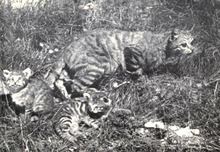Higher classification Wildcat | Phylum Chordata Scientific name Felis silvestris cafra Rank Subspecies | |
 | ||
Similar Felis, Wildcat, Felidae, Asiatic wildcat, Mammal | ||
Southern african wildcat top 5 facts
The Southern African wildcat (Felis silvestris cafra) is one of five subspecies of the wildcat, and is native to southern and south-eastern Africa. It was formerly considered conspecific with the African or Near Eastern wildcat (F. s. lybica), but has tentatively been recognised as a distinct subspecies on the basis of genetic analysis. Morphological evidence suggests the break between the two African subspecies to occur in the south-east, in the area of Tanzania and Mozambique.
Contents
- Southern african wildcat top 5 facts
- Characteristics
- Distribution and habitat
- Ecology and behaviour
- Threats
- References
In Afrikaans it is called 'vaalboskat'; in Swahili 'kaka mwiw', 'kimbum', or 'kaka pori'; in Herero 'ochawhi'; in Ndebele 'igola'. It is also known in English as the 'bush cat'.
Characteristics
The body of the Southern African wildcat is marked with vertical stripes but these can vary from faint to quite distinct. The tail is ringed with black and has a black tip. The chin and throat are white and the chest is usually paler than the rest of the body. The feet are jet black underneath. There are two colour phases; iron-grey, with black and whitish speckling, and tawny-grey, with less black and more buffy speckling. In appearance it is very similar to a domestic cat, although the legs are proportionately longer. The most distinguishable characteristic is the rich reddish-brown colour on the backs of the ears, over the belly and on the back legs. Its body length is 46–66.5 cm (18.1–26.2 in) with a 25–36 cm (9.8–14.2 in) long tail; and weight range 2.4–5.5 kg (5.3–12.1 lb).
Distribution and habitat
The Southern African wild cat is widely distributed throughout Africa south of the equator, but does not occur along the Namibian coast. It tolerates a wide range of habitats that provide some sort of cover.
Ecology and behaviour
Southern African wildcats are largely nocturnal, finding cover in which to rest during the day. Their habits are solitary, except for mating and raising their young, and they are highly territorial. They are adaptable predators, preferring to hunt small rodents, but able to change their diet according to seasonal and longer-term prey abundances and availability; they have been observed to take other small mammals, birds, reptiles, amphibians, insects and other invertebrates. The largest recorded prey include hares, springhares and birds up to the size of guineafowl.
Threats
The main threat to the survival of the wild subspecies in its pure form is its tendency to interbreed with domestic cats anywhere near human habitations. Other threats include persecution by hunters and local farmers, as well as habitat loss.
